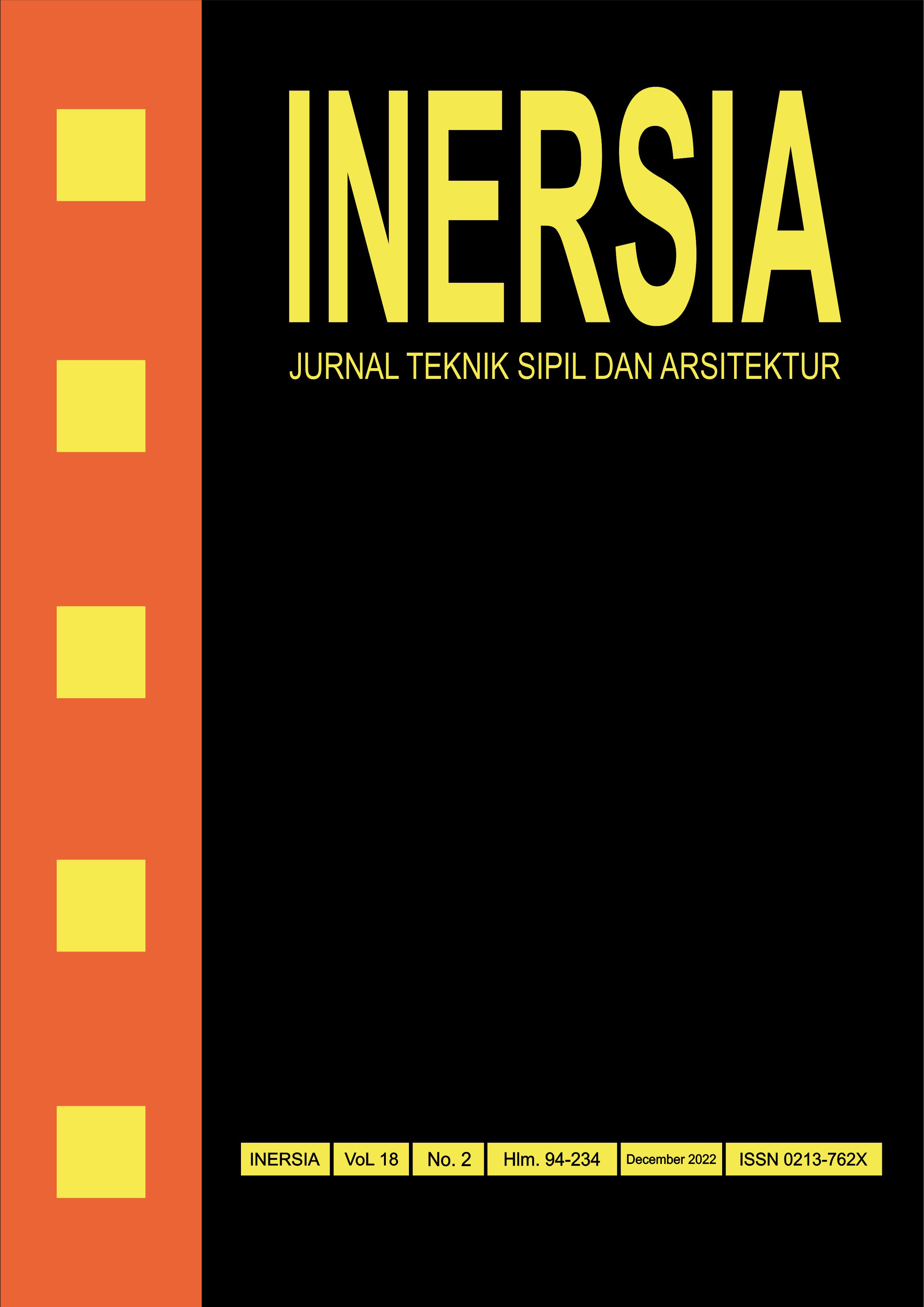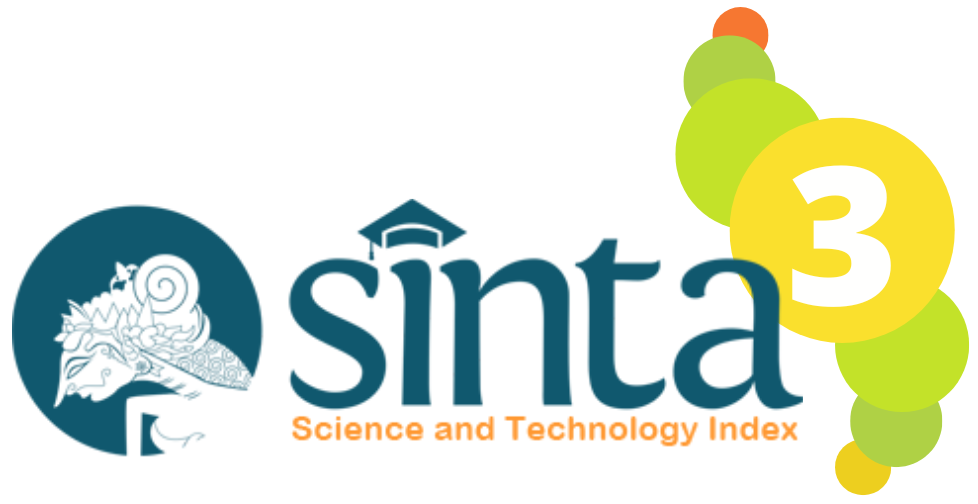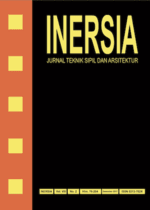Preparedness of Tsunami Disaster in Pandeglang Region Due to The Activity of Mount Krakatau
DOI:
https://doi.org/10.21831/inersia.v18i2.54054Keywords:
Tsunami, Building damage, Evacuation route, Evacuation time, SimulationAbstract
Pandeglang Regency is one of the areas with the most building damage in The 2018 Anak Krakatau Tsunami. The tsunami in 2018 was caused by the activity of Anak Krakatau Volcano in the form of an avalanche of material on the volcano's cliffs. The subdistricts in Pandeglang Regency affected by the tsunami were Carita Subdistrict, Labuan Subdistrict, and Panimbang Subdistrict. This research evaluates potential damage to buildings to determine the condition of the existing land, determines an evacuation route to a temporary evacuation site (TES), and simulates a tsunami evacuation using this evacuation route. Parameters of run-up height and building type are used as parameters for assessing building damage. The determination of TES is influenced by run-up height, elevation, and distance from the shoreline. Evacuation route planning and evacuation simulation are based on the assumed number of evacuees and the scenario of a tsunami evacuation. The results showed moderate damage to buildings in Carita Subdistrict, Labuan Subdistrict, and Panimbang Subdistrict. The examination of existing land as TES, namely Carita Vacant Land, Carita 1 Middle School, LDII Labuan Mosque, Labuan Shelter Building, Panimbang Vacant Land. According to the tsunami evacuation scenario during the day, evacuation time results for 25-30 minutes with an average speed of > 1 m/s. The tsunami evacuation time at night is free of obstacles or with obstacles for 50-85 minutes with an average speed of 1 m/s. The tsunami evacuation time at night is full of free and obstacle-free tours for 60-100 minutes with an average speed of 0.5 m/s. Evacuation time based on simulation results is compared with evacuation time calculated by ETA and other studies as data validation to determine the probability of community preparedness in the Pandeglang Regency. The preparedness community in Pandeglang Regency is in the ready category by 25% in the Carita subdistrict, Labuan subdistrict, and Panimbang Subdistrict.
References
T. Solihuddin, H. L. Salim, S. Husrin, A. Daulat, And D. Purbani, "Dampak Tsunami Selat Sunda Desember 2018 Di Provinsi Banten Dan Upaya Mitigasinya," J. Segara, Vol. 16, No. 1, Pp. 15–28, 2020, Doi: 10.15578/Segara.V16i1.8611.
Triyono, Kurniah, N. Andriana, T. Kusumawati, And N. Hardianto, "Pedoman Kesiapsiagaan Menghadapi Gempa Bumi Dan Tsunami Berbasis Masyarakat," Badan Nas. Penanggulangan Bencana, No. December, P. 17, 2014.
Badan Geologi, "Laporan Tahunan 2018", Kesdm, 2019,Https://Doi.Org/10.1016/J.Cam.2017.10.014.
Bnpb, "Pedoman Teknik Pembuatan Peta Bahaya Rendaman Tsunami," Bandung Pus. Penelit. Mitigasi Bencana Inst. Teknol. Bandung, 2013.
N. Chasanah, H. D. Armono, S. Sujantoko, And J. W. R. Ginting, "Pemodelan Penjalaran Tsunami Akibat Erupsi Gunung Anak Krakatau Beserta Skenario Dike, Studi Kasus Teluk Jakarta," J. Tek. Its, Vol. 9, No. 1, 2020, Doi: 10.12962/J23373539.V9i1.50609.
K. Mosby, T. Birch, A. Moles, And K. E. Cherry, "Disasters," Handb. Rural Aging, Pp. 111–115, 2021, Doi: 10.7591/9781501701498-008.
F. W. Ariani Et Al., "Studi Run-Up Gelombang Pada Offshore Breakwater Di Pantai Slamaran Pekalongan," J. Oceanogr., Vol. 2, No. 1, Pp. 1–8, 2013.
"Stability Evaluation Of Sea Wall Construction At Erie Vilage Location Nusaniwe District Amboina City Joseph Christina * , Miegsjeglorie.V. Putuhena **," 1999.
E. Kusumaningrum, "Evaluasi Kriteria Kerusakan Bangunan Rumah Tinggal Sederhana Akibat Gempa Bumi," Pp. 1–152, 2017, [Online]. Available: Https://Dspace.Uii.Ac.Id/Bitstream/Handle/123456789/27859/11914011 Evy Kusumaningrum.Pdf?Sequence=1&Isallowed=Y
K. Rehman And Y. S. Cho, "Building Damage Assessment Using Scenario Based Tsunami Numerical Analysis And Fragility Curves," Water (Switzerland), Vol. 8, No. 3, 2016, Doi: 10.3390/W8030109.
D. M. Wiebe And D. T. Cox, "Application Of Fragility Curves To Estimate Building Damage And Economic Loss At A Community Scale: A Case Study Of Seaside, Oregon," Nat. Hazards, Vol. 71, No. 3, Pp. 2043–2061, 2014, Doi: 10.1007/S11069-013-0995-1.
A. Suppasri, K. Fukui, K. Yamashita, N. Leelawat, H. Ohira, And F. Imamura, "Developing Fragility Functions For Aquaculture Rafts And Eelgrass In The Case Of The 2011 Great East Japan Tsunami," Nat. Hazards Earth Syst. Sci., Vol. 18, No. 1, Pp. 145–155, 2018, Doi: 10.5194/Nhess-18-145-2018.
S. Reese, B. A. Bradley, J. Bind, G. Smart, W. Power, And J. Sturman, "Empirical Building Fragilities From Observed Damage In The 2009 South Pacific Tsunami," Earth-Science Rev., Vol. 107, No. 1–2, Pp. 156–173, 2011, Doi: 10.1016/J.Earscirev.2011.01.009.
A. E. Ä°demen, E. Acar, And S. M. Åžener, "Assessing The Adaptive Re-Use Potential Of Buildings As Part Of The Disaster Management Process," Int. J. Archit. Environ. Eng., Vol. 10, No. 3, Pp. 433–439, 2016.
I. Satyarno, "Vulnerability Of {Indonesian} Community Houses To Earthquake Disaster," Proc. 9th Int. Symp. Mitig. Geo-Disasters Asia, No. January, Pp. 19–20, 2011.
G. B. Sahetapy, H. Poli, And Suryono, "Analisis Jalur Evakuasi Bencana Banjir Di Kota Manado," Spasial, Vol. 3, No. 2, Pp. 70–79, 2016.
L. W. Aji, "Identifikasi Jalur Dan Tempat Evakuasi Tsunami Berdasarkan Fema P646 Pada Objek-Objek Wisata Pantai Di Kabupaten Gunungkidul (Studi Kasus: Pantai Nguyahan, Ngobaran Dan Ngrenehan)," Inersia Lnformasi Dan Ekspose Has. Ris. Tek. Sipil Dan Arsit., Vol. 16, No. 1, Pp. 24–37, 2020, Doi: 10.21831/Inersia.V16i1.31313.
T. H. Briggs, "A Note," J. Educ. Psychol., Vol. 19, No. 5, P. 360, 1928, Doi: 10.1037/H0066879.
K. L. Steudel-Numbers And C. M. Wall-Scheffler, "Optimal Running Speed And The Evolution Of Hominin Hunting Strategies," J. Hum. Evol., Vol. 56, No. 4, Pp. 355–360, 2009, Doi: 10.1016/J.Jhevol.2008.11.002.
F. Imamura, A. Muhari, E. Mas, M. H. Pradono, J. Post, And M. Sugimoto, "Tsunami Disaster Mitigation By Integrating Comprehensive Countermeasures In Padang City, Indonesia," J. Disaster Res., Vol. 7, No. 1, Pp. 48–64, 2012, Doi: 10.20965/Jdr.2012.P0048.
Y. Goto, M. Affan, Agussabti, Y. Nurdin, D. K. Yuliana, And Ardiansyah, "Tsunami Evacuation Simulation For Disaster Education And City Planning," J. Disaster Res., Vol. 7, No. 1, Pp. 92–101, 2012, Doi: 10.20965/Jdr.2012.P0092.
R. Triatmadja, "Science Of Tsunami Hazards Numerical Simulations Of An Evacuation From A Tsunami At Parangtritis Beach In Indonesia," J. Tsunami Soc. Int., Vol. 34, No. 1, P. 50, 2015.
A. Muhari Et Al., "The December 2018 Anak Krakatau Volcano Tsunami As Inferred From Post-Tsunami Field Surveys And Spectral Analysis," Pure Appl. Geophys., Vol. 176, No. 12, Pp. 5219–5233, Dec. 2019, Doi: 10.1007/S00024-019-02358-2.
P. S. Putra, A. Aswan, K. A. Maryunani, E. Yulianto, S. H. Nugroho, And V. Setiawan, "Post-Event Field Survey Of The 22 December 2018 Anak Krakatau Tsunami," Pure Appl. Geophys., Vol. 177, No. 6, Pp. 2477–2492, Jun. 2020, Doi: 10.1007/S00024-020-02446-8.
Syamsidik, Benazir, M. Luthfi, A. Suppasri, And L. K. Comfort, "The 22 December 2018 Anak Krakatau VolcanoVolcanogenic Tsunami On Sunda Strait Coasts, Indonesia: Tsunami And Damage Characteristics," Nat. Hazards Earth Syst. Sci., Vol. 20, No. 2, Pp. 549–565, 2020, Doi: 10.5194/Nhess-20-549-2020.
W. Soviana, "Analisis Kerentanan Bangunan Gedung Dalam Menghadapi Bencana Tsunami Di Kecamatan Kuta Alam Banda Aceh," J. Dialog Penanggulangan Bencana, Vol. 6, No. 1, Pp. 54–63, 2015.
M. Fatir, "Peraturan Kepala Bnpb," Bnpb, Vol. 7, No. 6, Pp. 1–25, 2012.
Downloads
Published
How to Cite
Issue
Section
License
Authors who publish with INERSIA journal agree to the following terms:
- Authors retain copyright and grant the INERSIA journal right of first publication with the work simultaneously licensed under Creative Commons Attribution License (CC BY 4.0) that allows others to share the work with an acknowledgment of the work's authorship and initial publication in this journal.
- Authors can enter into separate, additional contractual arrangements for the non-exclusive distribution of the published version of the work (e.g., post it to an institutional repository or edit it in a book), with an acknowledgment of its initial publication in this journal.
- Authors are permitted and encouraged to post their work online (e.g., in institutional repositories or on their website) before and during the submission process, as it can lead to productive exchanges, as well as earlier and greater citation of published work.

INERSIA by https://journal.uny.ac.id/index.php/inersia was distributed under a Creative Commons Attribution 4.0 International License











